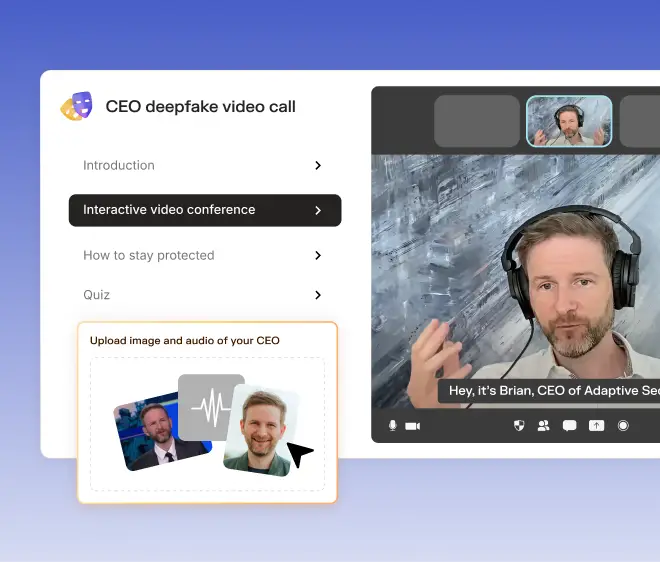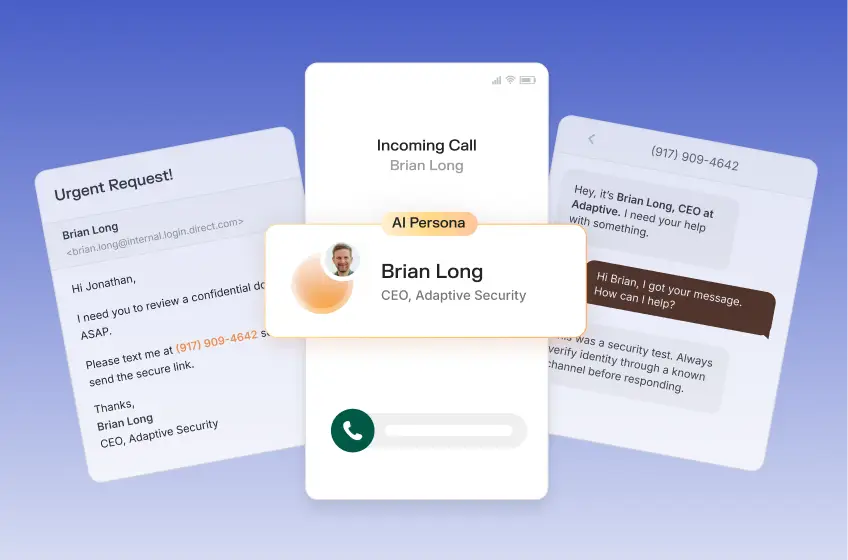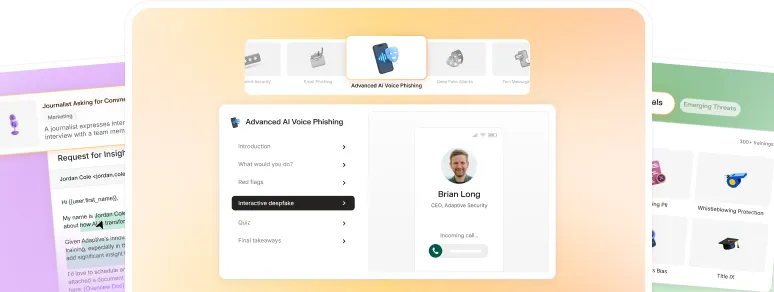What’s the most effective deepfake protection for enterprise use?
After all, the threat landscape has undergone a fundamental shift. While some organizations still focus on traditional email phishing, cybercriminals are orchestrating AI-powered phishing attacks across voice calls, video conferences, social media, and beyond.
According to Verizon’s annual Data Breach Investigations Report, 60% of data breaches involved the human element, including social engineering attacks.
Enterprise security leaders can’t rely on perimeter defenses alone.
Evolving threats demand AI safety tools for enterprises that address the full spectrum of AI phishing, from deepfake video calls impersonating executives to synthetic voice cloning targeting login credentials.
The question isn’t whether your organization will face these threats but whether your security posture can adapt fast enough to counter a devastating attack.
AI’s Multi-Channel Social Engineering Revolution
Traditional phishing attacks follow predictable patterns. Suspicious links, urgent language, and grammatical errors once served as reliable red flags.
AI, however, has rendered these assumptions obsolete.
Today’s social engineering campaigns leverage machine learning (ML) to craft personalized messages that mirror authentic communication styles.
According to an iProov report, the risk of deepfakes is on the rise. 47% of organizations, in fact, have encountered a deepfake security incident.
Consider the attack vector that's keeping CISOs awake at night: An AI-generated video of your CEO requesting an emergency wire transfer during a ‘confidential’ video call. The synthetic video quality is indistinguishable from authentic footage, complete with accurate facial expressions and voice patterns.
Financial institutions face particular vulnerability here.
When Arup reported a $25 million loss to deepfake fraud in early 2024, it marked a turning point in how enterprises view AI cybersecurity threats. The attack combined voice cloning, deepfake video, and social engineering across multiple channels, including email, phone, and video conference.
Your AI safety tools for enterprises must now detect threats that not only mimic humans but also recreate them in their entirety.
Comparison of AI-powered social engineering attack vectors
Synthetic Identity Networks: When AI Creates Entire Personas
The most sophisticated attacks don't impersonate real people. They invent them.
AI-powered synthetic identity creation has evolved beyond simply generating profiles; it now encompasses a broader range of capabilities.
Cybercriminals deploy entire networks of AI-created personas, complete with:
- Multi-year social media histories generated in minutes
- Professional LinkedIn profiles with fabricated work experiences
- Authentic-looking personal photos created by generative AI
- Behavioral patterns that pass traditional identity verification systems
- Cross-platform consistency that validates the fake identity
These synthetic identities infiltrate enterprise networks through recruitment processes, vendor relationships, and partnership discussions.
Synthetic identity theft is on the rise. Thompson Reuters estimates that the now-common cybercrime costs businesses between $20 billion and $40 billion.
The challenge for data protection teams lies in determining the optimal timing for detection. Traditional identity verification tools screen for known fraud patterns, but synthetic identities have no fraud history. They appear legitimate until the moment of attack.
Advanced identity verification tools now incorporate behavioral biometrics and real-time authentication to counter these threats. However, implementation requires integration with existing network security infrastructure and comprehensive risk management frameworks.
Real-Time Voice Manipulation: The New Frontier of CEO Fraud
Voice cloning technology has reached a terrifying milestone: real-time voice synthesis during live phone calls.
Unlike pre-recorded deepfake audio, real-time voice cloning allows attackers to conduct extended conversations while maintaining the vocal characteristics of their target.
The technology requires as little as a few seconds of source audio, which is easily obtained from public-facing videos or speaking engagements.
In fact, imposter scams remained a top fraud category in 2023, with reported losses of $2.7 billion, according to the Federal Trade Commission (FTC). With the recent AI explosion, we can only imagine how much worse it’s gotten since then.
The attack methodology follows a disturbing pattern. Cybercriminals research organizational hierarchies, identify key financial decision-makers, and time their attacks during periods when verification is challenging: late evenings, weekends, or during business travel.
The good news is enterprise-grade phishing prevention tools have evolved to address this threat with features such as:
- Voice authentication systems that analyze multiple vocal biomarkers
- Real-time call analysis that detects synthetic audio patterns
- Integration with existing security awareness training programs
- Behavioral monitoring that flags unusual request patterns
Security awareness training platforms must now prepare employees for scenarios beyond email phishing. Your team needs phishing simulations that include voice manipulation attempts, deepfake video calls, and cross-platform social engineering campaigns.
Cross-Platform Attack Orchestration: AI's Coordinated Campaigns
Modern social engineering attacks don't rely on single attack vectors. Instead, they coordinate across platforms.
AI-powered attack orchestration combines email phishing, social media manipulation, voice calls, and video conferences into unified campaigns.
Attackers use machine learning to analyze target responses across channels, adapting their approach in real-time based on engagement patterns.
The sophistication level really is unprecedented. For example, consider this typical multi-vector attack sequence:
- Research phase: AI scrapes public information about target executives and organizational structure.
- Trust building: Synthetic social media profiles engage with targets over weeks or months.
- Context establishment: Attackers reference specific projects, relationships, or recent events in initial contact.
- Channel escalation: Movement from text-based communication to voice and video calls.
- Authority exploitation: Deepfake technology impersonates trusted figures during crucial moments.
Cybersecurity platforms designed for this threat landscape must provide unified visibility across all communication channels. Traditional email security solutions miss many multi-channel attacks.
AI-powered threat intelligence tools for enterprise use now incorporate behavioral analytics that detect coordinated campaigns across platforms. These systems analyze communication patterns, timing correlations, and content similarities to identify orchestrated attacks before they reach critical phases.
Real-time behavioral monitoring tools for enterprises have become so essential to detecting these coordinated campaigns. They establish baseline communication patterns for individual users, and they flag deviations that suggest external manipulation or impersonation.
Building Resilient Human Firewalls: Security Awareness Training for the AI Era
Your employees remain the most critical defense layer, but traditional security awareness training is no longer enough to ensure they’re prepared for combat.
AI-enhanced social engineering necessitates advanced training approaches that incorporate psychological manipulation techniques and technological deception.
Static training modules that focus on identifying suspicious emails miss the complexity of modern attacks.
Effective security awareness training for the AI era must include:
- Interactive deepfake detection exercises using real-world examples
- Voice manipulation recognition training with audio samples
- Cross-platform threat scenario simulations
- Regular updates reflecting emerging AI attack techniques
- Behavioral psychology education focusing on manipulation tactics
Phishing simulations have expanded beyond email to include voice calls, video conferences, and social media interactions.
Measuring success, however, can be a challenge.
Traditional metrics like click rates on simulated phishing emails don't capture employee preparedness for voice cloning or deepfake video attacks. Modern training platforms track multi-modal engagement and scenario-based responses to provide more accurate risk assessments.
Incident response protocols must also evolve.
When an employee receives a suspicious deepfake video call, your response procedures should include immediate verification protocols, isolation of the communication channel, and rapid threat assessment capabilities.
Enterprise Defense Architecture: Integrating Tools for Comprehensive Protection
How many AI safety resources are in your enterprise’s toolbox?
Defending against AI-powered social engineering requires layered cybersecurity tools for enterprise that work together seamlessly. No single solution addresses the full threat spectrum.
Your defense architecture should integrate technical detection capabilities with human awareness programs, creating multiple layers of validation for high-risk communications and transactions.
Enterprise cybersecurity tools for AI-enhanced threat defense
Email security platforms
Advanced email security solutions now incorporate AI-powered content analysis that detects subtle linguistic patterns associated with AI-generated text.
Enterprise organizations need comprehensive email protection that addresses both traditional phishing and AI-enhanced social engineering attempts.
- Microsoft Defender for Office 365 uses machine learning to analyze writing styles and flag content that deviates from normal communication patterns.
- Proofpoint email protection integrates behavioral analytics that consider sender reputation, content analysis, and recipient risk factors.
- Cofense's AI-powered phishing detection capabilities focus specifically on social engineering indicators, analyzing email content for psychological manipulation techniques.
- Mimecast provides real-time threat intelligence that updates detection algorithms based on emerging AI-generated content patterns.
Voice authentication and clone detection tools
Real-time voice verification has become increasingly critical as voice cloning technology continues to reach new levels of sophistication. To be effective, enterprise voice security platforms must detect synthetic audio during live conversations while maintaining a high-quality user experience.
- Pindrop's voice security platform analyzes over 1,380 unique audio features to detect synthetic voice generation in real-time phone calls.
- Sensity AI specializes in deepfake detection across multiple media types, including real-time voice analysis with API integration for enterprise communication systems.
- IRONSCALES has developed deepfake protection specifically designed for enterprise email and communication platforms.
Identity verification and behavioral monitoring
Are there advanced identity verification tools for enterprises? How many of these top enterprise tools offer real-time behavior monitoring?
Traditional identity verification falls short against synthetic identities and AI-generated personas. Modern enterprise solutions require multi-factor authentication combined with behavioral pattern analysis.
- SentinelOne's behavioral monitoring capabilities extend beyond traditional endpoint detection to include communication pattern analysis and baseline user profiling.
- Advanced identity verification solutions now incorporate multiple authentication factors including facial biometrics, voice patterns, and behavioral characteristics.
- Real-time behavioral analytics platforms create comprehensive user profiles that are difficult for AI-generated synthetic identities to replicate.
SOC and SIEM platform integration
What are the best cybersecurity automation tools for enterprise SOCs?
Security operations centers need AI-powered correlation capabilities that identify social engineering campaigns across multiple communication channels. Integration with existing security infrastructure enables automated response workflows.
- Splunk's security automation platform provides machine learning capabilities that correlate social engineering indicators across multiple data sources.
- Torq's SOC automation specifically addresses social engineering detection through automated workflow responses and verification procedures.
- Darktrace's AI-driven SOC technologies use unsupervised machine learning to detect anomalous communication patterns in real-time.
Security awareness training platforms
Traditional training approaches fail to prepare employees for AI-enhanced social engineering attacks. Modern platforms must provide interactive simulations that address deepfakes, voice cloning, and multi-channel threats.
- Adaptive Security leads the market in comprehensive deepfake and AI threat training, offering interactive simulations that simulate sophisticated social engineering attempts.
- AI-powered simulation platforms can replicate voice cloning scenarios, deepfake video recognition training, and cross-platform attack simulations.
- Integrated training programs ensure consistent messaging and coordinated response protocols across enterprise security awareness initiatives.
Unified cybersecurity platforms
Enterprise security leaders increasingly seek integrated platforms that provide visibility and control across all communication channels. Comprehensive solutions must address the full spectrum of AI-enhanced social engineering threats.
- End-to-end security platforms must incorporate email security, voice authentication, identity verification, and behavioral monitoring within unified management interfaces
- Cloud security posture management (CSPM) integration ensures AI threat detection extends to cloud-based communication and collaboration platforms
- Enterprise platform selection criteria should prioritize integration capabilities, real-time detection accuracy, and comprehensive AI threat coverage
The Future of Enterprise Social Engineering Defense
So, what are the best cybersecurity tools for large enterprises?
Remember, AI-powered social engineering represents a significant shift in the evolution of cybersecurity threats.
Organizations that adapt their defense strategies to address multi-channel, AI-enhanced attacks will maintain resilient security postures. Those who continue to focus solely on traditional phishing defenses will find themselves vulnerable to increasingly sophisticated threats.
Your AI safety tools for enterprises must evolve beyond reactive detection to predictive analysis and comprehensive protection. The integration of technical solutions with human awareness training creates the powerful defense architecture necessary for the AI era.
The question isn't whether your organization will encounter these threats; it's whether you'll be prepared when they arrive.
Ready to strengthen your defense against AI-powered social engineering? Discover how Adaptive Security's comprehensive platform addresses deepfake detection, voice cloning threats, and advanced security awareness training.




We are a team of passionate technologists. Adaptive is building a platform that’s tailor-made for helping every company embrace this new era of technology without compromising on security.
Contents



Want to download an asset from our site?




.avif)
.avif)
.avif)



